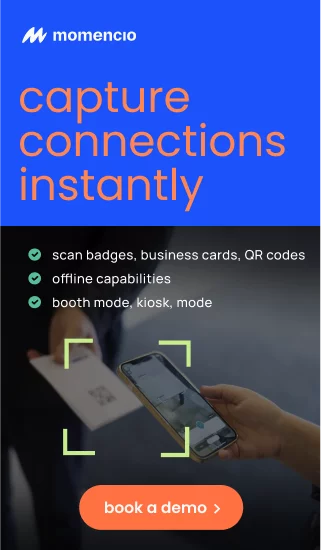Lead capture strategy is a crucial aspect of any successful marketing campaign. In simple terms, it’s the process of collecting contact information from potential customers who have shown an interest in your product or service. This contact information is usually in the form of an email address, phone number, or social media handle.
Once you have their details, you can follow up with them and turn them into paying customers. The goal of lead capture is to create a sustainable pipeline of interested prospects for your business. This blog post will discuss effective lead-capture strategies to help your business grow.
TL;DR: This ultimate guide to lead capture in 2025 outlines essential strategies for collecting and converting event leads. From interactive booth designs to digital lead capture tools, learn how to optimize your process and improve your conversion rates.
The pillars of a successful lead capture strategy
A lead capture strategy is not just about gathering contact details—it’s a thoughtful approach to attracting, engaging, and nurturing potential customers. Crafting an effective strategy involves aligning tools, content, and processes to create a seamless journey for prospects. Below are the essential elements for a robust lead capture strategy, tailored for search engines and enriched with actionable insights.
1. Define your target audience
To design a successful lead capture strategy, start with a clear understanding of your audience. Use data from customer personas, industry research, and analytics to pinpoint the behaviors, preferences, and pain points of your ideal leads. A targeted approach ensures you’re attracting quality prospects who are more likely to convert.
Pro tip: Use tools like Google Analytics and CRM data to refine your audience segments regularly.
2. Leverage high-quality, gated content
Content remains the backbone of any lead capture strategy. High-value gated content such as eBooks, whitepapers, or case studies can compel visitors to share their details in exchange for access. The exclusivity and perceived value of gated content add urgency, boosting conversion rates.
Example: Create a landing page offering a free “Lead Capture Strategy Template” and gate it with a simple form.
3. Optimize your lead capture forms
Your forms are where interest turns into action. Keep them concise and easy to fill out by asking only for essential information. Mobile-friendliness is non-negotiable, as over 50% of web traffic now comes from mobile devices.
Checklist for high-converting forms:
- Use auto-fill options for a seamless experience.
- Include social proof near the form, such as testimonials or trust badges.
- Add a compelling CTA, such as “Get My Free Guide Now.”
4. Integrate AI-powered tools for real-time lead engagement
Modern lead capture strategies rely heavily on technology. AI-powered tools like chatbots can engage website visitors in real time, answering their questions and collecting data without human intervention.
Hot tip: Use chatbots to offer personalized recommendations based on user behavior, further boosting engagement.
5. Employ multi-channel tactics
A strong lead capture strategy leverages multiple platforms, from social media and email campaigns to in-person events and webinars. Multi-channel engagement ensures you’re capturing leads wherever they are most active.
Fact: Businesses that adopt omnichannel strategies achieve a 91% higher retention rate.
6. Analyze and optimize the funnel
No strategy is complete without constant improvement. Use analytics tools to assess the performance of your lead capture methods. Track metrics like conversion rates, time on page, and form completion rates to identify areas for improvement.
A/B testing your landing pages can boost conversions by 49%.
7. Create a seamless post-capture experience
Capturing a lead is just the first step. A seamless follow-up strategy ensures leads don’t go cold. Use email automation, personalized messages, and CRM integrations to engage leads and guide them toward conversion.
Action step: Send a welcome email immediately after a lead signs up, outlining what they can expect next.
A well-crafted lead capture strategy not only attracts prospects but ensures they are nurtured effectively through the sales funnel. By combining high-quality content, advanced tools, and a customer-centric approach, businesses can maximize their conversion potential.
Bonus tip: Want to supercharge your strategy? Try out the momencio platform for seamless lead capture and post-event engagement. Its advanced features like badge scanning, CRM integration, and real-time analytics make it the ultimate tool for your marketing efforts.
The only lead capture strategy you need
Create high-quality content
Creating quality content is one of the most effective ways to capture leads. This can be in the form of blog posts, eBooks, whitepapers, or videos that provide value to your audience. About 76% of marketers use content to generate leads. When you create content that is informative and engaging, it attracts people to your website. And ultimately, it encourages them to share their contact information in exchange for access to the content.
To capture leads with your content, include a call-to-action (CTA) at the end of your content. This could be a button or a form that invites readers to subscribe to your email list, download a free eBook, or attend a webinar. Make sure your CTA is clear, concise, and stands out from the rest of the content.
Use exit-intent pop-ups
Exit-intent pop-ups are a great way to capture leads from visitors who are about to leave your website. These pop-ups appear when the user is about to close the tab or move away from your website. In this lead capture strategy, the businesses usually offer a discount, a free trial, or access to exclusive content in exchange for the visitor’s email address.
To make your exit-intent pop-up effective, ensure it is visually appealing and offers value to your visitors. Also, keep the form simple and ask for only the necessary information, such as name and email address.
Conversion Sciences reveal that good quality exit pop-ups can save 10-15 percent of potentially lost visitors.
Create landing pages
Landing pages are excellent lead capture tools that allow businesses to create a targeted experience for their visitors. These pages can be designed for a specific product or service, event, or marketing campaign.
According to Hubspot, the average conversion rate across all industries is nearly 10 percent (to be precise, 9.7 %). It might be more or less based on which industry you’re operating in, but no one can ignore the importance of such a big conversion benchmark.
A landing page aims to get the details to convert visitors into loyal customers. Through this lead capture strategy, you can encourage them to take a specific action, such as filling out a form, and in return, offer them a free eBook. To increase the effectiveness of this lead capture system, ensure that they have a clear and compelling headline, a strong call-to-action, and a visually appealing design.
Offer gated content
Gated content refers to content that is hidden behind a form. Visitors need to fill in their details to access the content. This lead capture strategy is exceptionally beneficial because it adds a sense of urgency and exclusivity, encouraging visitors to share their contact information.
To implement this lead capture strategy, create a landing page that includes a form for visitors to fill in their details to access the content. But always try to add value to the content you’re offering in exchange for customer details.
Run social media contests
Social media contests are one of the best lead capture strategies to engage your audience. They make people share their details in exchange for a chance to win a prize.
To run a successful social media contest, choose a prize that is relevant to your audience and persuade them to share the contest with their friends. Also, ensure you have clear rules and instructions for entering the contest.
Attend events and trade shows
Attending events and trade shows is a great lead capture strategy to connect with potential customers. These events give you the opportunity to showcase your products or services and collect contact information from interested attendees.
For this lead capture example, create eye-catching signage and marketing materials that clearly communicate your brand and offerings. Also, make sure you have a lead capture system in place to capture information, such as a tablet or lead capture software. For example, you can use the momencio lead retrieval app to enhance the process efficiency.
Optimize forms
Forms are the primary lead capture tools to engage customers on your website. These forms are designed to collect user information, such as their name and email address. It’s essential to optimize them for maximum effectiveness.
To optimize your forms, you should keep them short and simple. Ask for only the essential information, and provide clear guidelines on how to fill out the form. Additionally, use auto-fill features and ensure that your forms are mobile-friendly to make it accessible for visitors to provide their contact information.
Social media
Social media platforms offer businesses an excellent opportunity to capture leads. Creating social media posts that resonate with your target audience can attract followers and turn them into leads.
To capture leads on social media, consider doing a giveaway that requires users to provide their contact information to enter. You can also create lead-generation ads that are specifically designed to capture contact information.
Webinars
These effective lead capture strategies allow businesses to showcase their expertise and provide value to their audience. By offering a free webinar on a topic that interests your target audience, you can attract leads and convert them into customers. Webinars are hot spots for attracting the audience. Eighty-one percent of professionals prioritize webinars over other forms of content for professional grooming.
To promote your webinar, use social media and email marketing to promote your webinar to reach your target audience. To ensure that your webinar effectively captures leads, include a call-to-action at the end that encourages attendees to provide their contact information.
Employ a lead capture software
Lead capture tools are an inevitable part of any business’ lead capture strategy. These solutions are designed to automate the lead capture process and make it more efficient.
Using lead capture tools, businesses can create opt-in forms or landing pages optimized to collect contact information from their target audience.
Conclusion
In short, a well-designed lead capture strategy helps businesses to acquire the customer’s contact information and nurture them into becoming loyal customers. The use of lead capture software solutions can significantly automate the process. If you’re looking for a reliable lead retrieval app, look no further than momencio.
With us, you can easily capture and manage leads from any event, trade show, or conference. With advanced analytics and reporting features, you can track your performance and make data-driven decisions to improve your lead capture strategy. So, if you’re ready to take your lead retrieval game to the next level, try momencio today!
momencio is by far the best event lead capture and sales enablement tool we have ever used. The platform is flexible and easy to use, while at the same time allowing us to do things that we have not been able to do in the past. We have been using momencio since late last year and we have already been able to see how our events are performing and the ROI that it has generated. momencio also integrated seamlessly with our Salesforce CRM and HubSpot.
Nikos Z. Tweet













